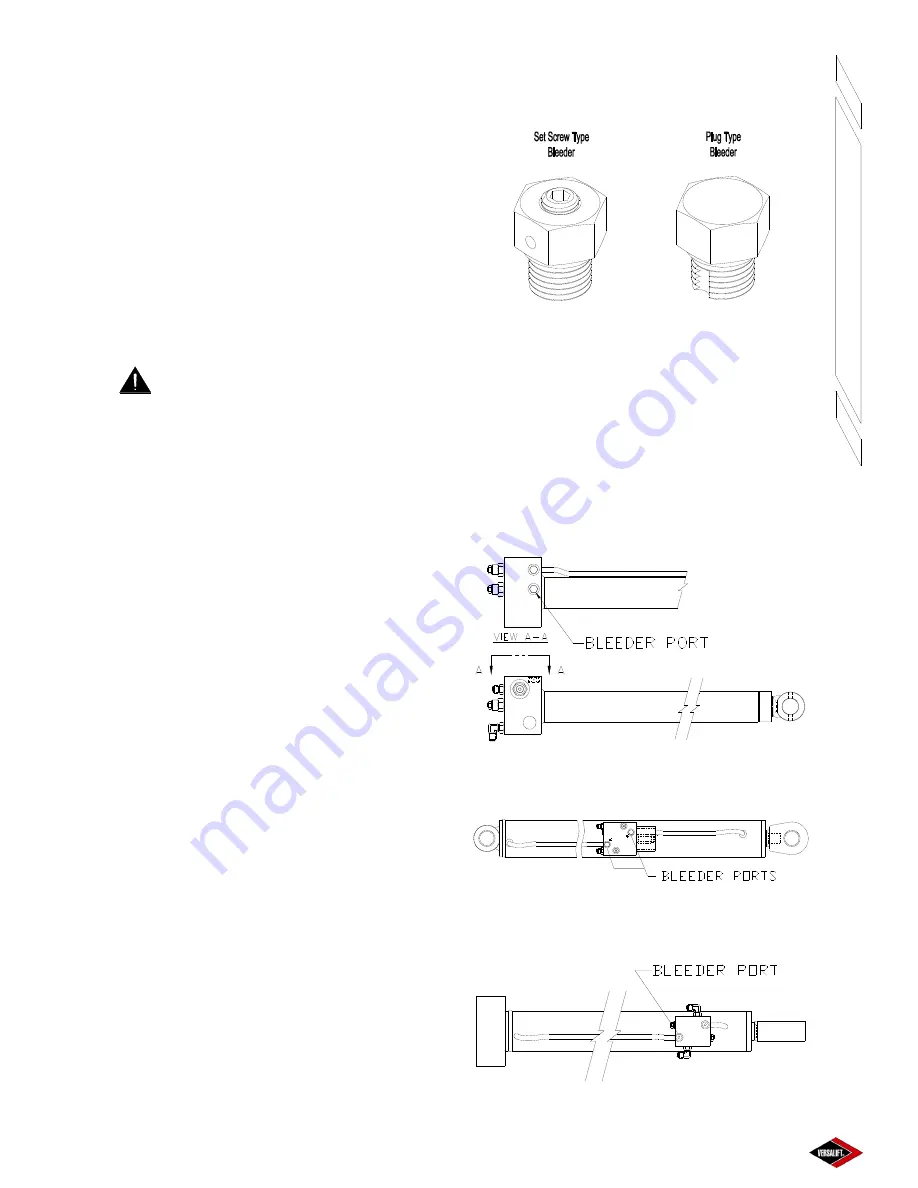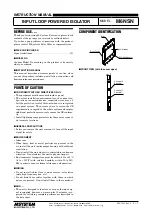
5-1
39014-03 06/16
VERSALIFT VST-36/40/47/52-I
EMERGENCY
OPERA
TION
Bleeder Ports
Figure 5.1
Set Screw Type Bleeder
- Turn the set screw slowly
using an Allen wrench to release load. Do not turn
the body. Oil is released from the hole on the side
of hex body.
Plug Type Bleeder
- Turn the entire plug slowly using
a wrench to release load. Do not remove the plug.
Oil is released from the notch in the threads. Torque
to 12-15 ft-lbs. after use.
Extension Cylinder Bleeder Port
Figure 5.2
Upper Cylinder Bleeder Ports
Figure 5.3
Lower Boom Cylinder Bleeder Port
Figure 5.4
Emergency operation may be required if an operator
is injured or the hydraulic system malfunctions. This
chapter describes the controls and features designed
to accommodate emergency operation and to
describe some procedures for responding to
emergency situations. In an emergency, the first
priority is always the safety of the personnel. Before
attempts are made to rescue personnel, make sure
the unit has not become electrically energized.
Identifying the problem and initiating emergency
procedures promptly helps minimize or possibly
prevents injuries. It is important to follow standard
work practices and safety regulations.
DANGER:
BEFORE ATTEMPTING
TO RESCUE PERSONNEL ON THE AERIAL LIFT,
ALWAYS MAKE SURE THAT THE TRUCK AND
THE AERIAL LIFT HAVE NOT BECOME
ELECTRICALLY ENERGIZED. CONTACT MADE
BY RESCUERS FROM THE GROUND WITH AN
ENERGIZED UNIT WILL CAUSE DEATH OR
SERIOUS INJURY.
CONTROL SELECTOR (Platform Override)
- If a
situation requires overriding the upper controls (i.e.
an injured operator in the platform), use the selector
control at the turret to transfer control to the lower
controls. The upper controls will not be operable
and the lower controls can be used to lower the
operator to the ground. Refer to lower controls
paragraph in Section 4, Operation, of this manual.
BLEEDER PORTS
- If the hydraulic system
becomes inoperable with an operator aloft, bleeder
ports on the cylinders (Figures 5.2, 5.3, and 5.4)
can be used to lower the booms and return the
operator to the ground. Qualified personnel at the
site are responsible for selecting the path of boom
decent. The unit may be equipped with two different
type of bleeder ports. Refer to Figure 5.1 for
identification and proper procedures for loosening
the bleeder ports. Be prepared for a flow of hot oil
escaping around the bleeder port and step away
from the boom path of descent. The speed at which
the lower boom drifts down depends on the rate of
oil loss.
EMERGENCY OPERATION
Содержание VST-36-I
Страница 2: ......
Страница 4: ......
Страница 6: ......
Страница 11: ...2 3 39014 03 06 16 VERSALIFT VST 36 40 47 52 I RESPONSIBILITIES SAFETY ...
Страница 12: ...2 4 RESPONSIBILITIES SAFETY 39014 03 06 16 VERSALIFT VST 36 40 47 52 I ...
Страница 18: ......
Страница 27: ...3 9 39014 03 06 16 VERSALIFT VST 36 40 47 52 I SPECIFICATIONS ...
Страница 28: ...3 10 39014 03 06 16 VERSALIFT VST 36 40 47 52 I SPECIFICATIONS ...
Страница 29: ...3 11 39014 03 06 16 VERSALIFT VST 36 40 47 52 I SPECIFICATIONS ...
Страница 30: ...3 12 39014 03 06 16 VERSALIFT VST 36 40 47 52 I SPECIFICATIONS ...
Страница 31: ...3 13 39014 03 06 16 VERSALIFT VST 36 40 47 52 I SPECIFICATIONS ...
Страница 36: ...3 18 39014 03 06 16 VERSALIFT VST 36 40 47 52 I SPECIFICATIONS ...
Страница 37: ...3 19 39014 03 06 16 VERSALIFT VST 36 40 47 52 I SPECIFICATIONS ...
Страница 38: ......
Страница 60: ...6 4 39014 03 06 16 VERSALIFT VST 36 40 47 52 I DAILY VISUAL INSPECTION ...
Страница 61: ...6 5 39014 03 06 16 VERSALIFT VST 36 40 47 52 I DAILY VISUAL INSPECTION ...
Страница 62: ...6 6 39014 03 06 16 VERSALIFT VST 36 40 47 52 I DAILY VISUAL INSPECTION ...










































